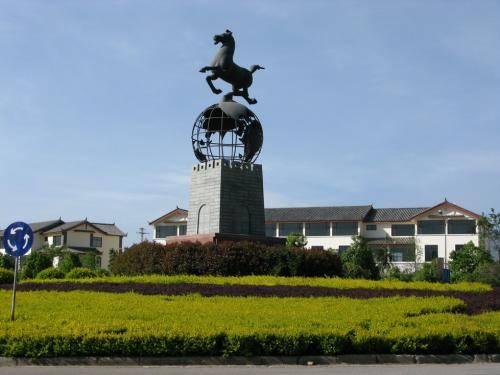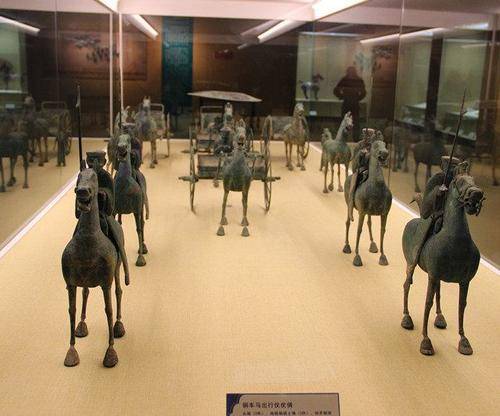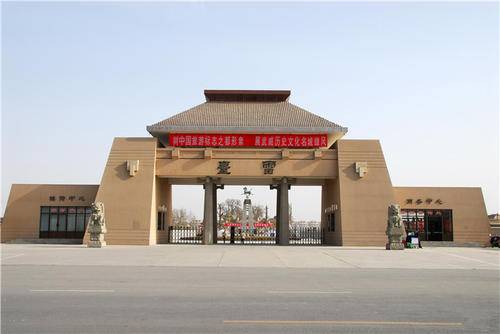Flying Horse Treading on a Swallow Square
Also known as Ma Chao Long Que or Bronze Galloping Horse, it was a bronze galloping horse from the Eastern Han Dynasty. Identified by the National Tourism Administration, it was unearthed from the Leitai Han Tomb in Wuwei in 1969 and has become a symbol of Chinese tourism. Since Leitai is the birthplace of the 'Flying Horse Treading on a Swallow,' the core of the park is naturally designed around this rare treasure. At the entrance is the Flying Horse Treading on a Swallow Square, with the majestic 'Flying Horse Treading on a Swallow' statue standing in the center of the square, surrounded by large relief walls that encapsulate the essence of Han culture.
Bronze Chariot and Horse Figurines
The Bronze Chariot and Horse Figurine procession consists of 99 exquisitely cast bronze statues. The Eastern Han Dynasty bronze chariot and horse figurines include dozens of bronze horses, each beautifully shaped and uniquely posed. There are vigorous and robust riders, strong and fierce chariot horses, and galloping steeds. Some figures stand tall and proud, some leap and bound, and some drive chariots. The bronze chariot and horse procession vividly depicts the spectacular scene of 'chariots rumbling and horses neighing'.
Leitai Han Culture Museum
Bid farewell to the bronze chariot and horse figurine procession and visit the Leitai Han Culture Exhibition Hall. Free admission. Of course, the highlight of the entire exhibition is still the 'Galloping Horse Treading on a Flying Swallow,' also known as the 'Heavenly Horse' and 'Number One Horse in the World.' The exhibits in the hall are meticulously replicated according to the original appearance and proportions when unearthed. It is reported that the genuine artifact is currently displayed in the Gansu Provincial Museum. From the exhibition hall, it is known that this national treasure was called 'Bronze Galloping Horse' when unearthed. After research by experts and scholars, it was named 'Horse Stepping on a Dragon Sparrow.' Later, the famous archaeologist Guo Moruo named it 'Galloping Horse Treading on a Flying Swallow' (despite many controversies). Eventually, it became the symbol of Chinese tourism. The 'Galloping Horse Treading on a Flying Swallow' has extremely high artistic value.
Leitai Temple
Leitai Temple is adjacent to the Han Culture Museum. From the exhibition hall, it is just a few steps to Leitai Temple. Admission to Leitai Temple is free. Leitai Temple is one of the famous Taoist temples in Wuwei, originally built during the Qing Dynasty. The main buildings of the temple include the Wind Hall, Lei Zu Hall, and the Three Emperors Hall. The entire temple complex is built on the renowned Leitai from the Jin Dynasty. Entering through the gate of Leitai Temple, the road on the right leads to the Han tomb, which requires an entrance fee, while going straight leads to Leitai...
Leitai Han Tomb
Coming down from Leitai, turn left to enter the Leitai Han Tomb area, which is the core area of the entire Leitai Park. There is an entrance fee to visit here, and the ticket costs 50 yuan. The Leitai Han Tomb is a national key cultural relic protection unit, and the large Eastern Han tomb is located just below Leitai. The Han tomb was discovered in September 1969 by local farmers while digging a war preparation tunnel at the southeast corner below the platform. After verification, it was identified as a large brick chamber tomb from the late Eastern Han Dynasty (186-219 AD), classified as Tomb No. 1 and Tomb No. 2. According to the inscription on the chest of the horse figurine, Tomb No. 1 is the tomb of 'Zhang Jun, the governor of Zhangye.'













